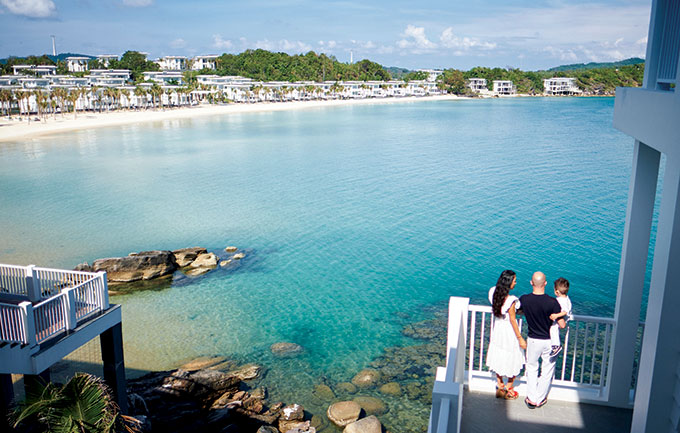
Ascott International Management, one of the leading international hotel management brands, signed a strategic cooperation agreement with the Cam Lam Investment Co., the investor of the Cam Ranh Bay Hotel and Resort, on July 16, to manage and operate the five-star serviced apartment and hotel on 13ha in the northern tourist area on Cam Ranh Peninsula in south-central Khanh Hoa province. Designed in a Santorini style from the Mediterranean, Cam Ranh Bay Hotel and Resort has 175 seafront villas, 908 hotel rooms, and serviced apartments with entertainment services.
CapitaLand’s wholly-owned lodging business unit, The Ascott Limited, is accelerating its growth globally with the signing of 26 properties with over 6,000 units across 22 cities and eleven countries and territories, including Vietnam. Ms. Lew Yen Ping, Country General Manager of Ascott International Management, Vietnam, told VET that, nowadays, guests no longer want to stay at the same location but in different places with enticing natural scenery, so regardless of the period of stay, they seek to enjoy the finer things in life. “That is why one of the most recent hotel management projects of Ascott is Cam Ranh Bay Hotel and Resort; a strategic partnership between Ascott and Cam Lam,” she added. “This partnership is a great opportunity for Ascott to continue expanding its network in Vietnam, one of its core markets worldwide.”
Enhanced presence
Vietnam has already witnessed the presence of major international hotel management brands. Wyndham Hotels & Resorts, the world’s largest hotel franchisor and a leading provider of hotel management services, officially arrived in Vietnam in February with the opening of the Wyndham Garden Hanoi Hotel. “Wyndham Garden is one of our most exciting brands and I am delighted to be able to introduce it to guests in Vietnam,” said Mr. Joon Aun Ooi, President and Managing Director, Wyndham Hotels & Resorts, South East Asia and Pacific Rim.
AccorHotels, meanwhile, announced in April 2018 the completion of its acquisition of Mövenpick Hotels & Resorts. The deal encompasses 100 per cent of Mövenpick share capital, as well as ownership of the Mövenpick brand for all activities related to the hospitality business, expanding its presence in the world. It operates 30 hotels with a network of ten brands in Vietnam: Sofitel, Sofitel Legend, MGallery, Pullman, Mövenpick, Grand Mercure, Novotel, Mercure, ibis, and Premier Residences and Premier Village. Highlights in 2019 include the upcoming openings of Pullman Phu Quoc (334 rooms), Novotel Hanoi Thai Ha (343 rooms), Movenpick Cam Ranh Bay (250 rooms), and Mövenpick Resort Waverly Phu Quoc (713 keys).
Similarly, acquiring Starwood’s hotel chain broadened the footprint of Marriott International in Vietnam. In addition to Hanoi and Phu Quoc Island, the Marriott brand is also found in Cam Ranh and Sapa, and the company also owns old hotel brands such as Le Méridien and Sheraton.
Owning nine famous global brands, the Intercontinental Hotels Group (IHG) manages luxury hotels and resorts in prime areas in Vietnam’s three major cities of Hanoi, Ho Chi Minh City, and Da Nang, including Intercontinental Hanoi Westlake Hotel, InterContinental Asiana Saigon Hotel, InterContinental Danang Sun Peninsula Resort, and InterContinental Phu Quoc, on Phu Quoc Island.
Vietnam’s market also sees the presence of brands such as Hyatt, Hilton Worldwide, and Best Western Premier, among others.
Fertile land
Vietnam is predicted to lead Asia-Pacific destinations in terms of average annual tourism growth over the next five years, according to the Asia Pacific Visitor Forecasts 2019-2023 report from the Pacific Asia Travel Association (PATA) released in March. It forecasts average growth of 14 per cent in international tourist arrivals to Vietnam during the 2018-2023 period. Figures from Vietnam’s General Statistics Office show that international visitors to Vietnam stood at nearly 8.5 million people in the first half of this year, up 7.5 per cent year-on-year.
Mr. Patrick Basset, Chief Operating Officer for Accor in Upper Southeast & Northeast Asia and the Maldives, told VET that Vietnam offers vibrant cultural attractions, modern infrastructure, diverse destinations, and ease-of-access. “Tourism in Vietnam continues to grow year-on-year and there is enormous potential for owners in a market that is developing so swiftly,” he said. “We see long-term potential to continue our expansion in Vietnam and introduce new brands into the market.”
Of a similar mind, Ms. Ping believes that Vietnam, with its beautiful scenery and fascinating history, culture, and cuisine, is an ideal destination for travelers on business or leisure and continues to attract attention from both domestic and foreign investors. “Vietnam remains the key and primary market for Ascott in the coming years,” she said. “It is one of the region’s most high-growth hospitality markets and has strong development prospects for our company.”
According to AccorHotels, some independent or local developments may not meet the international standards of their positioning. “The result of this is that investors will have to exercise greater discretion to determine the quality of the brand and development they choose to invest in,” said Mr. Basset. “When developers work with a group like Accor, they have access to experts who are able to form an appropriate strategy to meet the needs of a destination.”
Within half a decade, from 2015 to 2020, the number of middle-income households in Vietnam is projected to double, according to the Bookings Institute. This growth rate puts Vietnam in the top 6 most dynamic markets in the region, joining Indonesia, Thailand, Malaysia, the Philippines, and Singapore. JLL Vietnam’s figures reveal that the urban population in Southeast Asian cities is growing by about 2.2 per cent each year and the middle class is growing to 70 million, equivalent to 9 per cent annual growth to 2020. In particular, the proportion of middle-income households in Vietnam continues to grow. “This has motivated the resort real estate industry to continuously develop to meet the increasing demand of the market and is an opportunity for international hotel managers to enter the market,” Ms. Pham Kim Xuan, Head of Marketing at JLL Vietnam, told VET.
International hotel management brands have hundreds of years of experience between them and so cater to a large number of guests. Attaching an international brand to a hotel is a major factor attracting guests and ensuring sustainable revenue. “When investors purchase a branded apartment or residence there is also greater peace of mind because regulations are adhered to and the property is well maintained,” Mr. Basset said. “This is another major reason why international hotel groups are entering the market to provide global expertise to these developments.”
Obstacles exist
However, the market also poses many challenges for managers. JLL noted that many international hotel operators want to transfer important positions to Vietnamese people, instead of foreign personnel, but this process will take more time. Therefore, Ms. Xuan said, the shortage of human resources with qualifications and skills in tourism and hotels is an issue for managers and operators. According to the General Department of Tourism, employee numbers in the industry currently stand at some 2 million, while demand by 2020 is more than 4 million. Each year only about 20-30,000 specialized tourism workers graduate from training institutions in Vietnam.
Customers nowadays only need a residence that is convenient and comfortable and helps them settle down with ease. In the resort business model, one of the key expectations to fulfil is not only creating a sense of a home-away-from-home for guests but also allowing them to discover exciting activities the area has to offer, Ms. Ping explained. “This relies heavily on the level of attractiveness of the area and how stories of those places are told, so in this case, there are factors that are out of our control, being local policies and the planning of the city or province itself,” she said. “Sometimes, decisions have to be made at the governmental level. Therefore, in terms of tourism strategies, in order to lure more tourists, the city or province must actively tell captivating stories about its beauty, history, and culture.”
At the “Real Estate Investment Forum 2019: Risks and Opportunities” held on June 22, Mr. Nguyen Tran Nam, Chairman of the Vietnam Real Estate Association (VNREA), told the gathering that some legal provisions for resort real estate products are not clear. “Vietnam’s legal framework still lags behind the development of resort real estate,” he noted.
Mr. Basset, meanwhile, hopes greater transparency in governance and foreign investment legalities will attract greater international operators to develop branded residence projects in Vietnam.





















